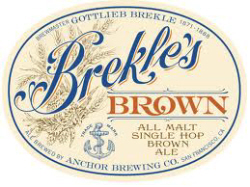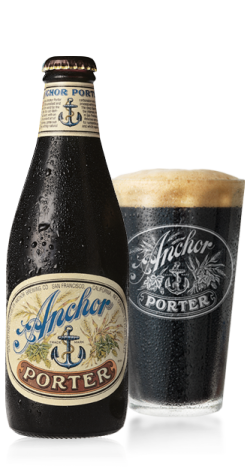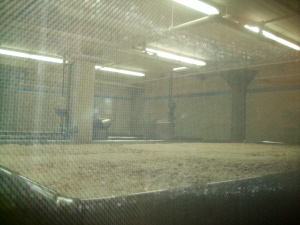
Anchor Brewing Company, Mariposa Street, San Francisco, California 94107
Top Tastings 2012 (Porter)
ABV: 6%, 5.6% and 5%
Origin: San Francisco, California, USA
Website: www.anchorbrewing.com
Despite numerous visits to San Francisco in recent years I hadn’t yet got round to visiting the famous Anchor brewery – arguably the motherlode of the current craft beer revival. I put that right in October 2012, joining a brewery tour and spending some time in the excellent company of head brewer Mark Carpenter.
Mark is something of a brewing legend himself. He’s been with the company, now based just below the summit of Potrero Hill in the east of the city, since 1971 and is now essentially the keeper of the flame since Fritz Maytag, who famously rescued Anchor and its unique Steam Beer in 1965, sold it on to two former executives of SKYY vodka in 2010.
I plan to write up that encounter in more detail at a later date, but the visit also proved a perfect opportunity to catch up on Anchor’s current range in the convivial tasting room next to the brewhouse, and remind myself of just how excellent it is. All the beers were tasted on keg as free samples.

Anchor Brekle’s Brown
Brekle’s Brown, launched in 2010 shortly after Fritz’s departure, is the first beer for which Mark was entirely responsible. Like many other Anchor products, it nods to earlier brewing practice. Gottlieb Brekle was a German immigrant who founded what would later become the Anchor brewery in a saloon near Russian Hill in 1871.
Back then, brown malts would have been the most easily available brewing grains and this robust contemporary take on the style nods to the past by including Munich and caramel malt alongside two-row pale to create a rich brown tone topped by a dense orange-tinged head.
I detected a very slight diacetyl note on a gritty malt-dominated aroma, also yielding citric notes from Citra, the single hop used. A lively palate began with toffeeish, slightly sugary malt, developing tingly hops, fresh citrus, orange marmalade and menthol-like spice.
The smooth finish turned lightly toasty with bitterish hop and cough candy notes. Overall this beautifully put together beer has proved a worthy addition to an already strong range, with the well judged use of Citra helping create a beer where fresh and juicy fruit flavours add drinkability and moreishness to a rich and chewy malt base.
Having saved steam beer from extinction, Fritz next turned to the resurrection of one of brewing’s great lost styles. Anchor Porter, the brewery’s second beer, first appeared in 1972. Almost certainly it was the first commercial example of a warm fermented porter created since the extinction of the style in Britain in the 1950s, and it made a vital contribution to reinstating porter, which had led the large scale industrialisation of brewing in 18th century London, to the vocabulary of world beer.
Anchor Porter happily remains a benchmark, a beer that’s both serious and approachable. The recipe is little changed since the 1970s – caramel, black and chocolate malts alongside pale to create a near-black colour, with a single hop, Northern Brewer in whole leaf form, for a vintage earthy British character.
A generous foamy and lacy light brown head yielded a very rich and roasty chocolate orange aroma with a hint of brown sugar and a dash of citrus zest. The roasty, grainy chaffy palate had hints of liquroice and caramel with a slightly medicinal, humbuggy note and earthy hop bitterness rumbling beneath. The swallow left a mouthful of smooth, malty, roasty flavour, with light coffee and herbal hints.
Overall the beer was the epitome of that perfect balancing act the best brewers achieve so well, with a deep dusky richness and a rewarding intensity of flavour that stops short of becoming overbearing. It’s one of many remarkable things about Anchor that a beer conceived as one of a kind four decades ago has proved difficult to equal ever since, despite the subsequent proliferation of competitors that Anchor itself helped inspire.
Read an earlier review of Anchor Porter.
It’s a challenge to pick just three featured beers from this brewery when there are so many good ones – Fritz’s second new beer, barley wine Old Foghorn, also remains a classic – but I couldn’t bring myself to leave out the beer that started it all.
Steam beer was a response by German brewers schooled in lager techniques to the primitive facilities and mild climate of Gold Rush-era San Francisco. Lack of refrigeration meant cold fermenting yeast strains had somehow to be used at warm temperatures. Broad, shallow fermenting vessels, rather similar to the koelschepen employed in lambic brewing, were a partial solution as the greater surface area permitted more rapid cooling, but the action of the yeast at uncomfortably high temperatures induced a particularly high carbonation and a distinctive flavour.
The origin of the term is uncertain – Anchor claims it referred to the steam given off when hot wort was exposed to the city’s characteristically cool ocean breezes. The brewery retains traditional shallow fermenters just for making steam beer, though they’re no longer exposed to the vagaries of the city’s atmosphere. Instead they’re locked in an airtight room, spotlessly clean and temperature controlled with filtered air, though clearly visible through thick glass.
Steam beer was once San Francisco’s everyday beer, a cheap blue collar refresher flowing from numerous breweries, but Prohibition put paid to almost all of them and by the 1960s Anchor was its last remaining exponent. Fritz Maytag trademarked the term, which is why subsequent revivalist essays in the style by other brewers are obliged to use the post hoc style designation California Common.
Anchor Steam Beer today is a deep golden-amber beer with a sunburst glow created by darkening pale malt slightly with caramalt, and a light, faintly yellowish tinged head. My sample had a crisp, grainy and slightly toffeeish aroma, and a prickly and carbonated but very easy drinking palate with a traditional hop burr – as with the porter, Northern Brewer is the only variety used.
Subtle spice and hint of fruit – an artifact of the hybrid fermentation method – added interest and the beer finished almost pilsner-like, with light hops and a slightly nutty but very rounded chewiness. Another example of the art of balance, it remains a well made and very drinkable beer.
All the brewery’s beers are flash pasteurised – a disappointment to some purists, but something for which Mark is unapologetic. When Fritz first got involved, bad hygiene and the attendant lack of quality and consistency was one of the first challenges he faced, and the priority he gave to cleanliness and reliability remains deeply embedded in the brewery’s tradition.







Leave a Reply